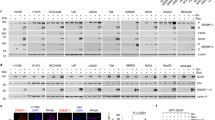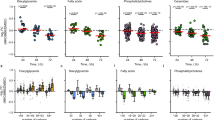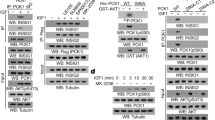Abstract
Elevated O-GlcNAcylation is associated with disease states such as diabetes and cancer. O-GlcNAc transferase (OGT) is elevated in multiple cancers and inhibition of this enzyme genetically or pharmacologically inhibits oncogenesis. Here we show that O-GlcNAcylation modulates lipid metabolism in cancer cells. OGT regulates expression of the master lipid regulator the transcription factor sterol regulatory element binding protein 1 (SREBP-1) and its transcriptional targets both in cancer and lipogenic tissue. OGT regulates SREBP-1 protein expression via AMP-activated protein kinase (AMPK). SREBP-1 is critical for OGT-mediated regulation of cell survival and of lipid synthesis, as overexpression of SREBP-1 rescues lipogenic defects associated with OGT suppression, and tumor growth in vitro and in vivo. These results unravel a previously unidentified link between O-GlcNAcylation, lipid metabolism and the regulation of SREBP-1 in cancer and suggests a crucial role for O-GlcNAc signaling in transducing nutritional state to regulate lipid metabolism.
This is a preview of subscription content, access via your institution
Access options
Subscribe to this journal
Receive 50 print issues and online access
$259.00 per year
only $5.18 per issue
Buy this article
- Purchase on Springer Link
- Instant access to full article PDF
Prices may be subject to local taxes which are calculated during checkout







Similar content being viewed by others
References
Boroughs LK, DeBerardinis RJ . Metabolic pathways promoting cancer cell survival and growth. Nat Cell Biol 2015; 17: 351–359.
Hart GW, Housley MP, Slawson C . Cycling of O-linked beta-N-acetylglucosamine on nucleocytoplasmic proteins. Nature 2007; 446: 1017–1022.
Wellen KE, Thompson CB . Cellular metabolic stress: considering how cells respond to nutrient excess. Mol Cell 2010; 40: 323–332.
Varki A, Cummings R, Esko J et al. Essentials of Glycobiology. Cold Spring Harbor Laboratory Press: NY, 1999.
Ozcan S, Andrali SS, Cantrell JE . Modulation of transcription factor function by O-GlcNAc modification. Biochim Biophys Acta 2010; 1799: 353–364.
Chou TY, Dang CV, Hart GW . Glycosylation of the c-Myc transactivation domain. Proc Natl Acad Sci USA 1995; 92: 4417–4421.
Kawauchi K, Araki K, Tobiume K, Tanaka N . Loss of p53 enhances catalytic activity of IKKbeta through O-linked beta-N-acetyl glucosamine modification. Proc Natl Acad Sci USA 2009; 106: 3431–3436.
McClain DA, Lubas WA, Cooksey RC, Hazel M, Parker GJ, Love DC et al. Altered glycan-dependent signaling induces insulin resistance and hyperleptinemia. Proc Natl Acad Sci USA 2002; 99: 10695–10699.
Hardiville S, Hart GW . Nutrient regulation of signaling, transcription, and cell physiology by O-GlcNAcylation. Cell Metab 2014; 20: 208–213.
Ferrer CM, Sodi VL, Reginato MJ . O-GlcNAcylation in cancer biology: linking metabolism and signaling. J Mol Biol 2016; 428: 3282–3294.
Caldwell SA, Jackson SR, Shahriari KS, Lynch TP, Sethi G, Walker S et al. Nutrient sensor O-GlcNAc transferase regulates breast cancer tumorigenesis through targeting of the oncogenic transcription factor FoxM1. Oncogene 2010; 29: 2831–2842.
Lynch TP, Ferrer CM, Jackson SR, Shahriari KS, Vosseller K, Reginato MJ . Critical role of O-Linked beta-N-acetylglucosamine transferase in prostate cancer invasion, angiogenesis, and metastasis. J Biol Chem 2012; 287: 11070–11081.
Ferrer CM, Lu TY, Bacigalupa ZA, Katsetos CD, Sinclair DA, Reginato MJ . O-GlcNAcylation regulates breast cancer metastasis via SIRT1 modulation of FOXM1 pathway. Oncogene 2017; 36: 559–569.
Baenke F, Peck B, Miess H, Schulze A . Hooked on fat: the role of lipid synthesis in cancer metabolism and tumour development. Dis Model Mech 2013; 6: 1353–1363.
Swinnen JV, Brusselmans K, Verhoeven G . Increased lipogenesis in cancer cells: new players, novel targets. Curr Opin Clin Nutr Metab Care 2006; 9: 358–365.
Santos CR, Schulze A . Lipid metabolism in cancer. FEBS J 2012; 279: 2610–2623.
Horton JD, Goldstein JL, Brown MS . SREBPs: transcriptional mediators of lipid homeostasis. Cold Spring Harb Symp Quant Biol 2002; 67: 491–498.
Walker AK, Jacobs RL, Watts JL, Rottiers V, Jiang K, Finnegan DM et al. A conserved SREBP-1/phosphatidylcholine feedback circuit regulates lipogenesis in metazoans. Cell 2011; 147: 840–852.
Beckner ME, Fellows-Mayle W, Zhang Z, Agostino NR, Kant JA, Day BW et al. Identification of ATP citrate lyase as a positive regulator of glycolytic function in glioblastomas. Int J Cancer 2010; 126: 2282–2295.
Li W, Tai Y, Zhou J, Gu W, Bai Z, Zhou T et al. Repression of endometrial tumor growth by targeting SREBP1 and lipogenesis. Cell Cycle 2012; 11: 2348–2358.
Rohrig F, Schulze A . The multifaceted roles of fatty acid synthesis in cancer. Nat Rev Cancer 2016; 16: 732–749.
Luo Z, Zang M, Guo W . AMPK as a metabolic tumor suppressor: control of metabolism and cell growth. Future Oncol 2010; 6: 457–470.
Laderoute KR, Amin K, Calaoagan JM, Knapp M, Le T, Orduna J et al. 5'-AMP-activated protein kinase (AMPK) is induced by low-oxygen and glucose deprivation conditions found in solid-tumor microenvironments. Mol Cell Biol 2006; 26: 5336–5347.
Li Y, Xu S, Mihaylova MM, Zheng B, Hou X, Jiang B et al. AMPK phosphorylates and inhibits SREBP activity to attenuate hepatic steatosis and atherosclerosis in diet-induced insulin-resistant mice. Cell Metab 2011; 13: 376–388.
Zadra G, Batista JL, Loda M . Dissecting the dual role of AMPK in cancer: from experimental to human studies. Mol Cancer Res 2015; 13: 1059–1072.
Greenspan P, Mayer EP, Fowler SD . Nile red: a selective fluorescent stain for intracellular lipid droplets. J Cell Biol 1985; 100: 965–973.
Guy CT, Cardiff RD, Muller WJ . Induction of mammary tumors by expression of polyomavirus middle T oncogene: a transgenic mouse model for metastatic disease. Mol Cell Biol 1992; 12: 954–961.
Eberle D, Hegarty B, Bossard P, Ferre P, Foufelle F . SREBP transcription factors: master regulators of lipid homeostasis. Biochimie 2004; 86: 839–848.
Anderson SM, Rudolph MC, McManaman JL, Neville MC . Key stages in mammary gland development. Secretory activation in the mammary gland: it's not just about milk protein synthesis!. Breast Cancer Res 2007; 9: 204.
O'Donnell N, Zachara NE, Hart GW, Marth JD . Ogt-dependent X-chromosome-linked protein glycosylation is a requisite modification in somatic cell function and embryo viability. Mol Cell Biol 2004; 24: 1680–1690.
Sundqvist A, Bengoechea-Alonso MT, Ye X, Lukiyanchuk V, Jin J, Harper JW et al. Control of lipid metabolism by phosphorylation-dependent degradation of the SREBP family of transcription factors by SCF(Fbw7). Cell Metab 2005; 1: 379–391.
Ferrer CM, Lynch TP, Sodi VL, Falcone JN, Schwab LP, Peacock DL et al. O-GlcNAcylation regulates cancer metabolism and survival stress signaling via regulation of the HIF-1 pathway. Mol Cell 2014; 54: 820–831.
Buzzai M, Bauer DE, Jones RG, Deberardinis RJ, Hatzivassiliou G, Elstrom RL et al. The glucose dependence of Akt-transformed cells can be reversed by pharmacologic activation of fatty acid beta-oxidation. Oncogene 2005; 24: 4165–4173.
Itkonen HM, Minner S, Guldvik IJ, Sandmann MJ, Tsourlakis MC, Berge V et al. O-GlcNAc transferase integrates metabolic pathways to regulate the stability of c-MYC in human prostate cancer cells. Cancer Res 2013; 73: 5277–5287.
Shaw RJ, Cantley LC . Decoding key nodes in the metabolism of cancer cells: sugar & spice and all things nice. F1000 Biol Rep 2012; 4: 2.
Chou TY, Hart GW, Dang CV . c-Myc is glycosylated at threonine 58, a known phosphorylation site and a mutational hot spot in lymphomas. J Biol Chem 1995; 270: 18961–18965.
Li X, Wu JB, Li Q, Shigemura K, Chung LW, Huang WC . SREBP-2 promotes stem cell-like properties and metastasis by transcriptional activation of c-Myc in prostate cancer. Oncotarget 2016; 7: 12869–12884.
Jones SF, Infante JR . Molecular Pathways: Fatty Acid Synthase. Clin Cancer Research 2015; 21: 5434–5438.
Busino L, Millman SE, Scotto L, Kyratsous CA, Basrur V, O'Connor O et al. Fbxw7alpha- and GSK3-mediated degradation of p100 is a pro-survival mechanism in multiple myeloma. Nat Cell Biol 2012; 14: 375–385.
Sodi VL, Khaku S, Krutilina R, Schwab LP, Vocadlo DJ, Seagroves TN et al. MTOR/mYC axis regulates O-GLcNAc transferase expression and O-GLcNAcylation in breast cancer. Mol Cancer Res 2015; 13: 923–933.
Lopez-Ibanez J, Pazos F, Chagoyen M . MBROLE 2.0-functional enrichment of chemical compounds. Nucleic Acids Res 2016; 44: W201–W204.
Acknowledgements
We thank Nicholas Xerri for technical support and Mignon Keaton for help in analyzing LC–MS metabolite data. This work was supported by NCI grants CA192868 (to VLS), CA183574 (to CMF) and CA155413 (to MJR).
Author information
Authors and Affiliations
Corresponding author
Ethics declarations
Competing interests
The authors declare no conflict of interest.
Additional information
Supplementary Information accompanies this paper on the Oncogene website
Supplementary information
Rights and permissions
About this article
Cite this article
Sodi, V., Bacigalupa, Z., Ferrer, C. et al. Nutrient sensor O-GlcNAc transferase controls cancer lipid metabolism via SREBP-1 regulation. Oncogene 37, 924–934 (2018). https://doi.org/10.1038/onc.2017.395
Received:
Revised:
Accepted:
Published:
Issue Date:
DOI: https://doi.org/10.1038/onc.2017.395
This article is cited by
-
FpOGT is required for fungal growth, stress response, and virulence of Fusarium proliferatum by affecting the expression of glucokinase and other glucose metabolism-related genes
Phytopathology Research (2024)
-
Protein post-translational modifications in the regulation of cancer hallmarks
Cancer Gene Therapy (2023)
-
A non-catalytic scaffolding activity of hexokinase 2 contributes to EMT and metastasis
Nature Communications (2022)
-
O-GlcNAcylation suppresses TRAP1 activity and promotes mitochondrial respiration
Cell Stress and Chaperones (2022)
-
O-GlcNAc transferase regulates glioblastoma acetate metabolism via regulation of CDK5-dependent ACSS2 phosphorylation
Oncogene (2022)



